Welcome to our comprehensive guide on Anubias Hastifolia, the perfect aquatic plant for adding an elegant touch to your aquarium.
Whether you’re a seasoned aquarist or just starting out, Anubias Hastifolia is an excellent choice for enhancing the visual appeal of your tank.
In this article, we will explore the various aspects of Anubias Hastifolia, from its origins and growth characteristics to its compatibility with other aquatic plants and fauna.
By the end, you’ll have all the information you need to care for and incorporate this beautiful plant into your aquarium décor.
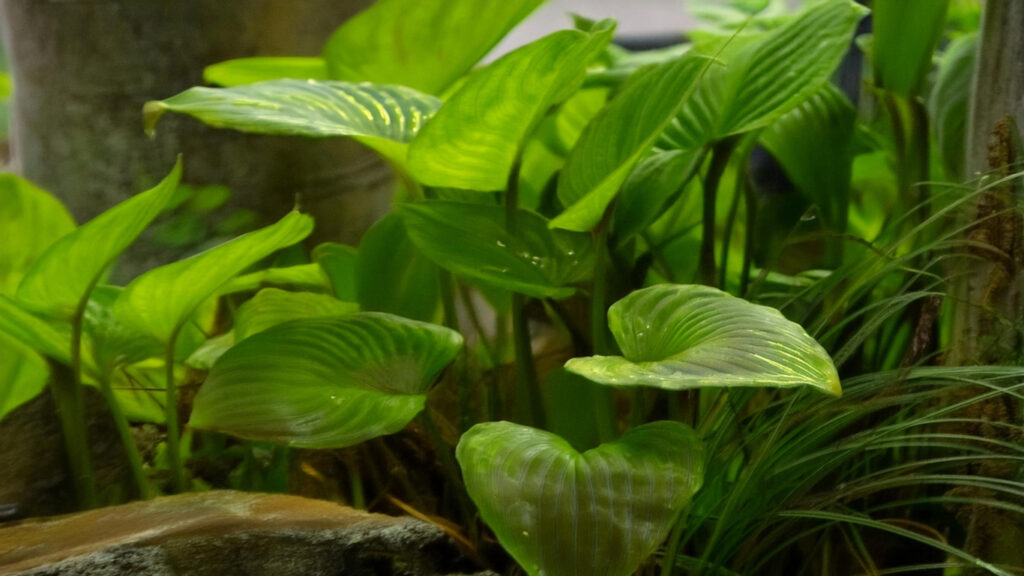
Key Takeaway
- Anubias Hastifolia is a popular aquatic plant known for its elegance and versatility in aquariums.
- It can be placed as a focal point, in hardscape arrangements, or as a background plant in an aquascape.
- Anubias Hastifolia is adaptable to a wide range of water conditions and can provide shelter for fish and invertebrates.
- Propagation can be done through rhizome division or by attaching new plants to substrates.
- It contributes to water quality improvement and oxygen production in the aquarium.
Quick Stats
| Attribute | Details |
| Family Name | Araceae |
| Origin | West Africa |
| Height | 20-50 cm (8-20 inches) |
| pH Range | 6.0 – 7.5 |
| CO2 Requirement | Low to None |
| Growth Rate | Medium |
| Care Level | Easy |
| Color Form | Green, with elongated heart-shaped leaves |
| Water Conditions | 22-28°C (72-82°F), soft to moderately hard water |
| Max Size | Up to 50 cm (20 inches) in height |
| Lighting | Low to Moderate |
| Supplements | Iron-rich fertilizer, beneficial for growth |
| Placement | Background, due to its taller growth |
| Propagation | Rhizome division |
What Is Anubias Hastifolia?
Aquascaping is the art of arranging aquatic plants, rocks, and décor in a visually appealing and natural-looking way in an aquarium. Anubias Hastifolia is a popular choice for aquascaping due to its elegant and versatile nature.
This section will discuss the ideal placement of Anubias Hastifolia in an aquascape, including its use as a focal point, in hardscape arrangements, or as a background plant.
Additionally, it will explore how Anubias Hastifolia can be combined with other aquatic plants to create beautiful and balanced aquascapes.
The Ideal Placement For Anubias Hastifolia
- Anubias Hastifolia can be placed in various positions within an aquascape to achieve different effects.
- It can be used as a focal point in the center or front of the tank to draw attention and create a dynamic composition. Alternatively, it can be placed in hardscape arrangements, such as attaching it to rocks or driftwood, to add dimension and visual interest.
- Anubias Hastifolia can also be used as a background plant, creating a lush and green backdrop for other aquarium elements. The ideal placement will depend on the overall design and aesthetic goals of the aquascape.
Creating Natural Refugia With Anubias Hastifolia
- Anubias Hastifolia can be used to create natural refugia within an aquascape. These refugia provide shelter and hiding places for fish and other aquatic creatures, promoting their overall well-being.
- By strategically placing Anubias Hastifolia near rocks, driftwood, or other structures, you can create small niches where fish and invertebrates can seek shelter and feel secure.
- This helps to replicate their natural habitat and contributes to a healthier and more balanced aquatic environment.
Combining Anubias Hastifolia With Other Aquatic Plants
- Anubias Hastifolia can be beautifully combined with other aquatic plants to create a diverse and visually appealing aquascape. Its broad, dark green leaves provide a striking contrast to plants with finer or lighter foliage, such as carpeting plants or stem plants.
- Anubias Hastifolia can also be used as a mid-ground or foreground plant, complementing taller background plants and creating depth in the aquascape.
- When combining Anubias Hastifolia with other plants, consider their similar or contrasting growth requirements, lighting needs, and overall aesthetic compatibility.
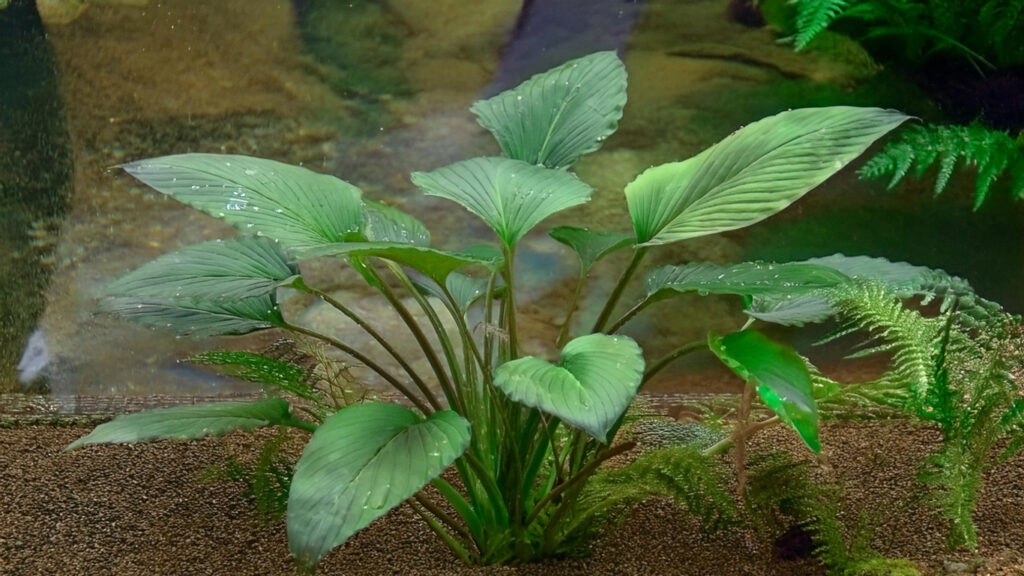
Anubias Hastifolia’s Natural Habitat
- Anubias Hastifolia is native to West Africa, where it is found in the natural habitat of rivers and streams. It thrives in shaded areas, often near riverbanks or in areas with dense vegetation.
- Anubias Hastifolia naturally grows attached to hard substrates like rocks or driftwood, using its adhesive roots to cling to these surfaces.
Adaptive Traits Of Anubias Hastifolia In The Wild
- Anubias Hastifolia has developed several adaptive traits that allow it to thrive in the wild. These traits contribute to its hardiness and ability to survive in various aquatic conditions.
- Anubias Hastifolia exhibits a slow growth rate, which enables it to adapt to low-nutrient environments. Additionally, its waxy leaves help minimize water loss and protect against herbivores. The plant’s ability to withstand strong currents in rivers and streams enhances its survivability.
Anubias Hastifolia’s Growth Characteristics
Anubias Hastifolia exhibits unique growth characteristics that contribute to its popularity as an aquatic plant for aquariums. In this section, we will delve into its growth rate, reaching maturity, and the structure and appearance of its leaves. Understanding these aspects will enable aquarists to provide proper care for Anubias Hastifolia and successfully incorporate it into their tank setup.
Rate Of Growth And Mature Size
- Anubias Hastifolia is known for its slow growth compared to many other aquatic plants. It typically takes several months to a year for this plant to reach its mature size.
- The actual growth rate can vary based on factors such as lighting conditions, water parameters, and nutrient availability. Aquarists should be patient and provide optimal conditions for the plant to reach its full potential.
Leaf Structure And Appearance
- Anubias Hastifolia’s leaves have a distinct structure and appealing appearance. They are broad and heart-shaped, often possessing a glossy or waxy texture.
The leaves’ color is typically dark, vibrant green, adding a lush and captivating element to the aquarium. Aquarists will appreciate the visual impact created by Anubias Hastifolia’s leaves, enhancing the overall aesthetics of the tank.

Anubias Hastifolia Propagation Techniques
Anubias Hastifolia is a versatile aquatic plant that can be propagated through various techniques. This allows aquarists to expand their plant collection or share plants with others.
This section will explore the two primary propagation techniques for it: rhizome division and attaching new plants to substrates.
Division Of Rhizomes
Rhizome division is a common and effective method of propagating this plant. The rhizome is the thick root stalk from which the leaves grow. To propagate Anubias Hastifolia through rhizome division, follow these step-by-step instructions:
- Carefully remove the plant from the aquarium and gently rinse the rhizome to remove debris or algae.
- Identify a healthy rhizome section with at least two leaves and carefully separate it from the main plant using a clean, sharp knife or scissors.
- Ensure that each divided section has at least two leaves for successful resprouting.
- Plant each divided section in a suitable substrate or attach it to a rock or driftwood using one of the methods described in the next section.
- Place the newly divided sections back into the aquarium, securely anchored and positioned in the desired location.
- To promote healthy growth, provide optimal conditions for the newly divided sections, including appropriate lighting, water parameters, and nutrient levels.
Attaching New Plants To Substrates
Attaching new Anubias Hastifolia plants to substrates like rocks or driftwood can provide stability and enhance the aquarium’s visual appeal.
Two common methods for attaching Anubias Hastifolia to substrates are superglue and cotton thread.
The Superglue Method
- Ensure the substrate is clean and dry.
- Apply a small amount of aquarium-safe cyanoacrylate-based superglue to the base of the this plant.
- Press the plant firmly against the desired substrate, holding it in place for a few seconds to ensure adhesion.
- Avoid applying excess glue, as it may be visible and potentially harmful to the plant and aquatic life.
The Cotton Thread Method
- Prepare a thin cotton thread or fishing line.
- Wrap the cotton thread around this plant rhizome or base multiple times, securing it tightly.
- Tie the thread to the chosen substrate, such as a rock or driftwood, ensuring the plant is firmly attached.
- Over time, the Anubias Hastifolia roots will grow and adhere to the substrate, further strengthening the attachment.
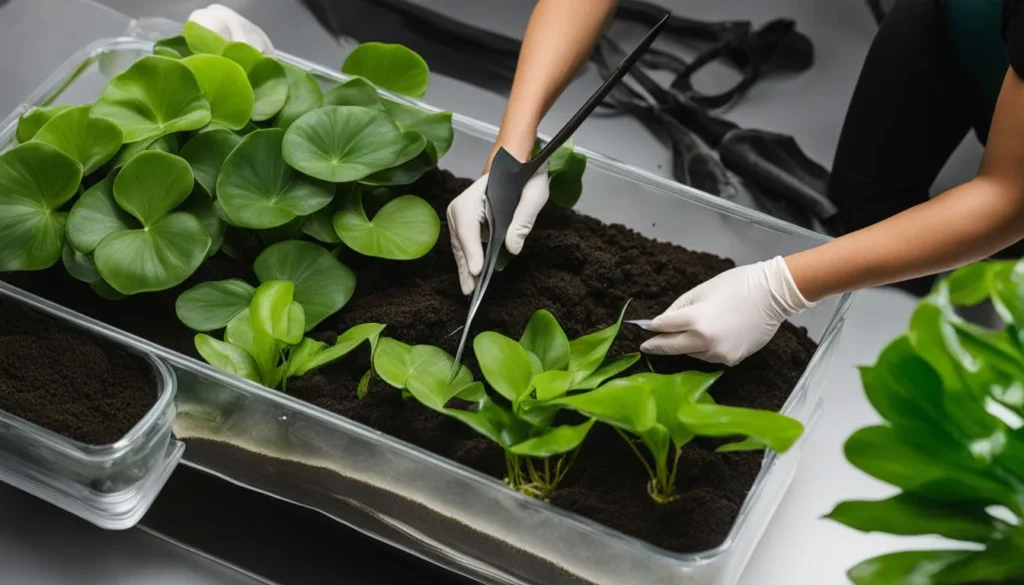
Anubias Hastifolia Propagation Techniques Comparison
| Propagation Technique | Advantages | Considerations |
| Rhizome Division | Allows for rapid propagation and expansion of plant collection. | Requires a healthy parent plant and careful separation of the rhizome to prevent damage. |
| Superglue Method | Provides a secure and visually appealing attachment to substrates. | Superglue may be visible and potentially harmful if applied excessively. |
| Cotton Thread Method | Allows for flexibility in adjusting the position and attachment of the plant. | Requires time for the roots to grow and firmly attach to the substrate. |
Anubias Hastifolia Substrate Preferences
- this plant is a versatile aquatic plant with specific substrate preferences that can greatly impact its growth and overall health.
- While it is commonly found as an epiphytic plant attached to rocks or driftwood, it can also be planted directly in the substrate under certain conditions.
- The ideal substrate for Anubias Hastifolia allows proper root anchoring. It should be a combination of fine-grained and nutrient-rich materials to provide stability and a source of essential nutrients.
- A suitable substrate for Anubias Hastifolia can include a mix of aquatic soil, sand, and clay, creating a loose yet supportive base.
- The roots of this plant are essential for its growth and stability. They anchor the plant to the substrate and provide a secure foundation.
- When planting it in the substrate, it is crucial to ensure that the roots are not buried too deeply, as this can lead to rotting and harm the plant. Instead, carefully bury the roots just below the surface of the substrate, leaving the rhizome exposed.
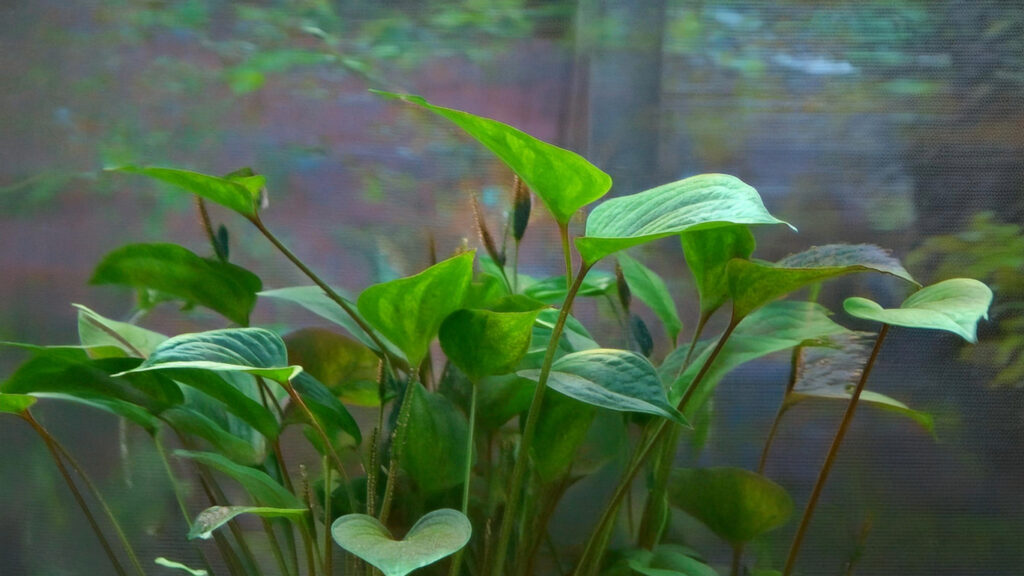
Lighting Requirements For Anubias Hastifolia
- Like any other plant, Anubias Hastifolia requires specific lighting to thrive in an aquarium. Proper lighting is crucial for the plant’s photosynthesis process and overall health. In this section, we will explore the ideal lighting conditions for Anubias Hastifolia, including the range of light intensities it can tolerate and the optimal lighting levels for its healthy growth.
- Anubias Hastifolia is known for its adaptability to a wide range of lighting conditions. It is considered a low-light plant, meaning it can thrive in environments with lower levels of light intensity. However, this doesn’t mean it can only survive in low-light conditions.
- Anubias Hastifolia can also tolerate moderate to high lighting levels, making it a versatile choice for various tank setups.
- When it comes to low-light tanks, Anubias Hastifolia can be placed in areas with limited access to direct sunlight or artificial light.
- It can thrive under shade or lower-intensity lighting, making it an excellent option for aquariums with less powerful lighting setups or tanks placed in darker areas of a room.
- Anubias Hastifolia can be placed in areas with direct or intense light exposure for tanks with moderate to high lighting.
- This plant can adapt to higher light intensities without harm, as long as the temperature and other environmental conditions are suitable.
- To ensure the proper lighting conditions for Anubias Hastifolia, it is essential to consider factors such as the wattage and spectrum of the light source.
- Aquarium LED lights are a popular choice as they provide adjustable brightness levels and customizable spectrum settings to meet the plants’ specific needs.

| Lighting Intensity | Recommended Placement |
| Low to moderate light | Shaded areas of the aquarium |
| Moderate to high light | Areas with direct or intense light exposure |
Varieties And Similar Species
Anubias Hastifolia is part of a diverse group of Anubias species. There are several varieties of Anubias Hastifolia available, each with its own unique characteristics and growth habits.
Some popular varieties include Anubias barteri and Anubias nana.
These varieties differ in size, leaf shape, and growth rate, offering aquarists a range of options to choose from when incorporating Anubias Hastifolia into their aquariums.
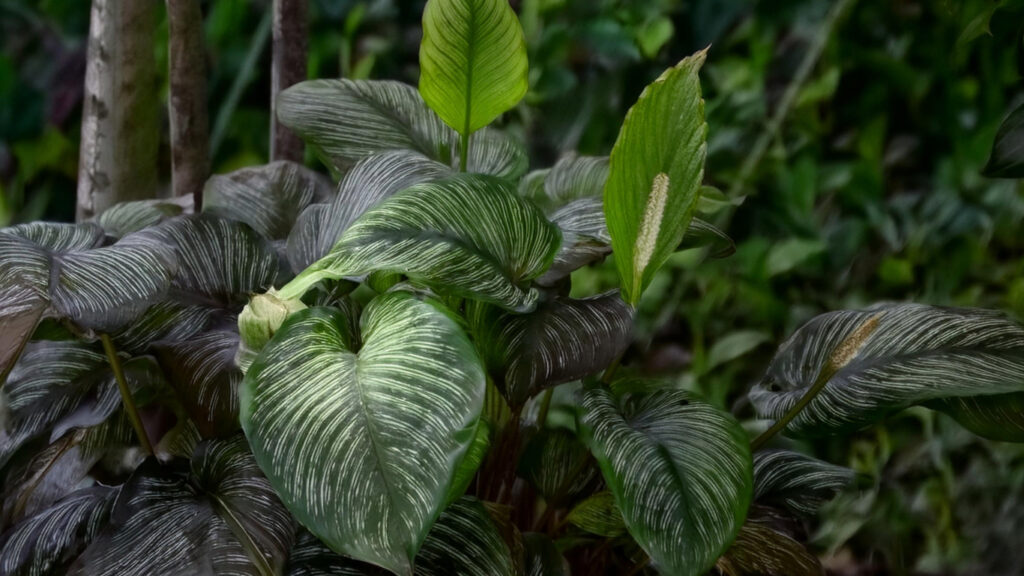
| Variety | Characteristics |
| Anubias barteri | A larger variety with broad, lanceolate leaves |
| Anubias nana | A smaller variety with compact, round leaves |
In addition to the different varieties of Anubias Hastifolia, there are other similar Anubias species that can be used as alternatives or additions to Anubias Hastifolia in aquariums.
These species share similar growth requirements and make excellent companions for Anubias Hastifolia. Some popular similar species include Anubias afzelii, Anubias congensis, and Anubias coffeefolia.
Temperature Range And pH Levels
- Anubias Hastifolia thrives in a specific temperature range and has specific preferences for pH levels. The recommended temperature range for Anubias Hastifolia is between 72°F and 78°F (22°C and 26°C).
- This temperature range provides favorable conditions for the plant’s growth and development. It is important to avoid extreme temperature fluctuations, as they can stress the plant and hinder its growth.
- Anubias Hastifolia also has specific pH preferences. The ideal pH level for this aquatic plant is slightly acidic to neutral, ranging from 6.0 to 7.5. Monitoring and maintaining the pH level within this range is important to ensure optimal growth and health for Anubias Hastifolia.
- Deviations from the preferred pH range can lead to stress and potential nutrient deficiencies in the plant.
Water Movement And Flow Impact
- Anubias Hastifolia has evolved to tolerate a wide range of water movement and flow in its natural habitat. While it can withstand gentle to moderate water movement, it does not thrive in high-flow environments.
- Excessive water flow can damage the plant’s delicate leaves and prevent proper nutrient uptake.
- When setting up the aquarium, it is important to consider the water flow near Anubias Hastifolia.
- Placing the plant in areas with reduced water flow, such as behind rocks or near calm areas, is recommended. This allows the plant to receive sufficient nutrients while minimizing the risk of damage caused by strong currents.
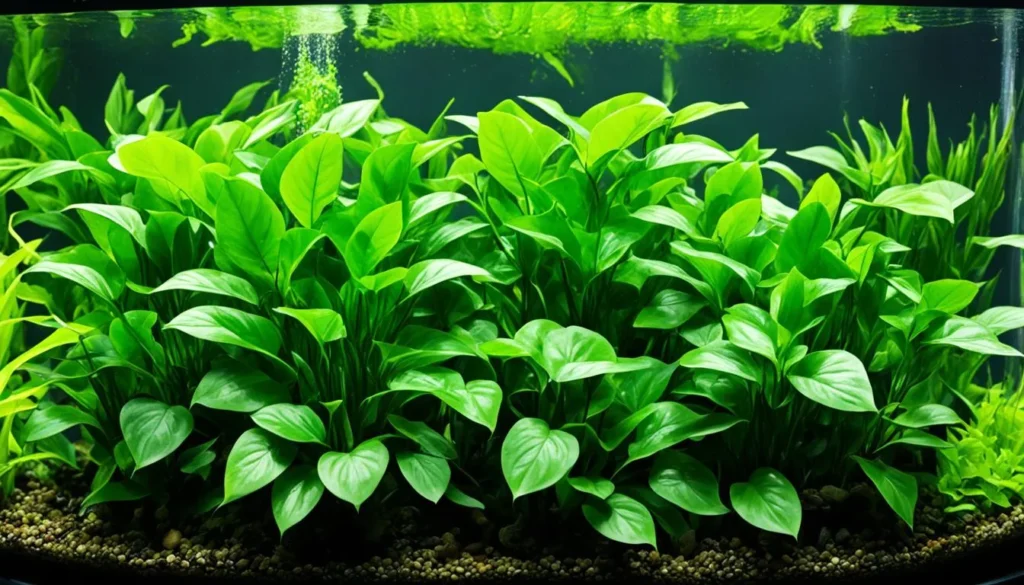
Compatibility With Fish Species
- Anubias Hastifolia is known for its compatibility with a wide range of fish species, making it a valuable addition to any aquarium.
- Its lush and dense foliage provides excellent hiding places and refuge for fish, creating a harmonious and natural environment.
- When selecting fish tankmates for Anubias Hastifolia, consider their size, temperament, and preferred water conditions to ensure compatibility.
Anubias Hastifolia As A Refuge For Shrimp And Invertebrates
- Anubias Hastifolia also serves as an ideal shelter and refuge for shrimp and other invertebrates. The large leaves and sturdy structure of Anubias Hastifolia provide secure hiding places for shrimps, allowing them to feel safe and protected.
- The plant’s root system also offers a refuge for various invertebrates, creating a thriving microhabitat within the aquarium. Incorporating Anubias Hastifolia into the tank not only enhances its aesthetic appeal but also provides a conducive environment for the well-being of these delicate creatures.
- When designing an aquarium with Anubias Hastifolia, consider the specific compatibility requirements of the shrimp and invertebrates you plan to include.
- Ensure that the water parameters, such as temperature and pH levels, are suitable for both the plant and the tank inhabitants. This holistic approach to aquarium design will create a balanced ecosystem where all organisms can thrive.
Common Issues And Remedies
Anubias Hastifolia might experience common issues such as yellowing leaves, black spots, or slow growth. Various factors, including poor water quality, nutrient deficiencies, or pest infestations can cause these issues.
- Yellowing Leaves: Yellow leaves could be a sign of nutrient deficiencies or inadequate lighting. To address this issue, consider supplementing the tank with liquid fertilizers or root tabs specifically formulated for aquatic plants. Additionally, ensure that the lighting conditions are suitable for Anubias Hastifolia’s needs.
- Black Spots: Black spots on the leaves could indicate the presence of algae or a bacterial infection. To prevent algae growth, regularly monitor the water parameters and maintain good water quality. If the black spots persist, you may need to remove affected leaves or treat the plant with a suitable antibacterial agent.
- Slow Growth: Anubias Hastifolia is known for its slow growth rate. However, if the growth rate seems unusually slow or stunted, it could be due to insufficient lighting or nutrient deficiencies. Check the lighting intensity and consider adjusting it or adding appropriate fertilizers to promote healthy growth.
Preventing Algal Growth On Leaves
Algal growth on Anubias Hastifolia leaves is a common issue in aquariums. Preventive measures can help keep the leaves clean and free from algae, ensuring the plant’s aesthetic appeal and overall health.
- Lighting Considerations: Excessive lighting or unbalanced light spectrums often promote algae growth. Adjust the lighting duration and intensity to provide optimal conditions for Anubias Hastifolia while minimizing algae growth. Consider using a timer to maintain a consistent lighting schedule.
- Nutrient Balance: Algae thrive in the presence of excess nutrients, particularly nitrates and phosphates. To control algae growth, regularly monitor the water parameters and implement proper nutrient management techniques, such as regular water changes and limiting nutrient inputs.
- Cleaning Techniques: Gently cleaning the leaves of Anubias Hastifolia can help remove any algae that may have accumulated. Use a soft brush or sponge to lightly scrub the leaves, being careful not to damage them. You can also consider introducing algae-eating fish or invertebrates, such as snails or shrimp, to help control algae growth naturally.
| Common Issues | Remedies |
| Yellowing Leaves | Supplement with liquid fertilizers or root tabs. Ensure suitable lighting conditions. |
| Black Spots | Monitor water parameters and maintain good water quality. Remove affected leaves or treat with appropriate antibacterial agents. |
| Slow Growth | Check lighting intensity and consider adjusting it. Supplement with appropriate fertilizers. |
Contribution To Water Quality
- Anubias Hastifolia plays a significant role in improving water quality within the aquarium. It acts as a natural filter, efficiently absorbing excess nutrients, such as nitrates, from the water column.
- By doing so, this plant helps maintain balanced nutrient levels, reducing the risk of algae blooms and promoting a healthier aquatic environment.
- In addition to nutrient absorption, It also purifies the water by removing pollutants and toxins. The plant’s extensive root system assists in the natural breakdown of organic waste, promoting a cleaner and healthier aquarium ecosystem.
Anubias Hastifolia And Oxygen Production
- Anubias Hastifolia significantly contributes to oxygen production in the aquarium through photosynthesis. Like all plants, It utilizes light energy to convert carbon dioxide into oxygen. As a result, the plant enhances the oxygen levels in the tank’s water, creating a healthier and more oxygen-rich environment for fish and other aquatic organisms.
- Furthermore, the oxygen released during photosynthesis helps support plant respiration and aids in maintaining a balanced ecosystem. Adequate oxygenation is crucial for the overall health and well-being of aquarium inhabitants.
- With its ability to improve water quality and enhance oxygen production, It plays a vital role in creating a thriving and balanced aquarium environment. Adding this beautiful plant to your tank enhances its visual appeal and contributes to the overall health and well-being of your aquatic ecosystem.
RELATED: Alternanthera Rosaefolia: A Pink Paradise In Your Aquarium
Conclusion
Anubias Hastifolia is an elegant and versatile aquatic plant that holds immense potential for enhancing the beauty and functionality of any aquarium.
Its unique growth characteristics and adaptability make it a valuable addition to the aquascaping community.
By understanding the origin of this plant and its preference for growth conditions, aquarists can provide the ideal environment for this plant to thrive.
Its ability to provide refuge and shelter for tank inhabitants adds an extra layer of value and contributes to a harmonious ecosystem.
Caring for it may come with challenges like algal growth and nutrient deficiencies.
However, these issues can be addressed effectively with proper preventive measures and troubleshooting techniques.
Frequently Asked Question
How Can I Optimize Growth Conditions For Anubias Hastifolia To Achieve Its Maximum Size And Leaf Development?
To optimize growth conditions for it, ensure it receives moderate lighting to prevent algae growth on its leaves while providing enough light for photosynthesis. Although this plant can tolerate a wide range of water parameters, it thrives in slightly acidic to neutral pH (6.0-7.5) and soft to moderately hard water.
Supplementing with CO2 is not necessary but can enhance growth and vitality. Ensure the rhizome is not buried in the substrate to prevent rot, and consider using liquid fertilizers to supply nutrients directly to the water column, which Anubias primarily absorbs through its leaves.
What Specific Challenges Might I Face With Anubias Hastifolia In An Aquarium Setting, And How Can I Overcome Them?
Common challenges with Anubias hastifolia include slow growth, susceptibility to algae growth on the leaves due to its slow growth rate, and potential rhizome rot.
To combat these, ensure the plant is placed in an area with moderate flow to discourage algae settling and supplement with a balanced liquid fertilizer to support growth without promoting excessive algae. Regularly clean the leaves gently with a soft brush if algae do appear.
Always attach this plant to driftwood or rocks rather than planting it in the substrate to avoid rhizome rot.
Can Anubias Hastifolia Be Effectively Propagated, And If So, What Method Works Best?
This plant can be propagated by dividing the rhizome. Use a sharp, sterilized knife or scissors to cut the rhizome into sections, ensuring each section has at least 2-3 leaves. After cutting, you can attach each section to a new piece of driftwood or rock using fishing line, thread, or super glue gel intended for aquarium use.
This method allows for efficient propagation and helps maintain the health of the plant by preventing overcrowding.
How Does Anubias Hastifolia Respond To Emersed Growth, And What Are The Benefits Of This Growth Method?
It adapts well to emersed growth, often resulting in faster growth rates and larger leaves. Emersed cultivation also encourages flowering, which is rarely seen in submerged conditions. To grow Anubias hastifolia emersed, maintain high humidity levels and keep the substrate moist but not waterlogged.
This can be achieved in a paludarium setup or a humid terrarium. Benefits of emersed growth include reduced risk of algae and better access to CO2 from the air, which can enhance growth and vitality.
What Advanced Strategies Can Be Employed To Manage And Prevent Algae Growth On Anubias Hastifolia Without Harming The Plant?
Managing and preventing algae growth on this plant involves balancing light and nutrients in the aquarium. Limit light exposure to 6-8 hours per day and consider using floating plants to diffuse strong lighting.
Regular maintenance, including water changes and removing excess nutrients, can also discourage algae growth. Introducing algae-eating fish or invertebrates, such as Otocinclus catfish or Amano shrimp, can help control algae naturally.
For stubborn algae, manually remove it with a soft toothbrush or by dipping the affected leaves in a diluted solution of hydrogen peroxide, ensuring the rhizome does not come into contact with the solution.
- Unveiling The Wonders Of Riccia Fluitans In Aquascapes - August 7, 2024
- Vallisneria Gigantea Var. Guide To Care And Cultivation At Home - July 31, 2024
- Vesicularia Dubyana Care & Growth Guide Tips For Beginner Gardeners - July 30, 2024
